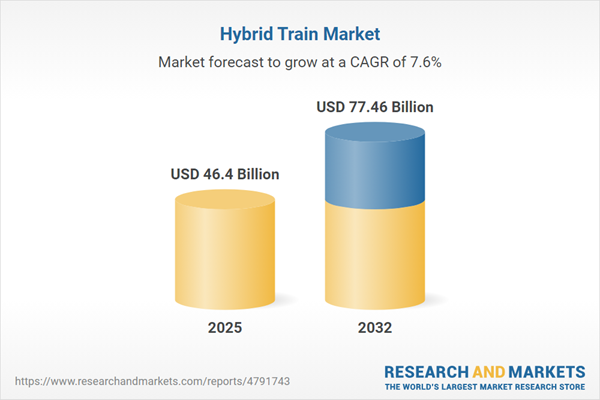Speak directly to the analyst to clarify any post sales queries you may have.
The hybrid train market is advancing rapidly as sustainable transport solutions become central to long-term rail strategies. Senior leaders now view hybrid trains as pivotal assets for modern rail networks, combining technical innovation with essential operational flexibility.
Market Snapshot: Hybrid Train Market Growth and Opportunities
The Hybrid Train Market grew from USD 43.22 billion in 2024 to USD 46.40 billion in 2025. It is expected to continue expanding at a CAGR of 7.56%, reaching USD 77.46 billion by 2032.
Driven by global decarbonization commitments and infrastructure modernization, hybrid trains are increasingly prioritized by rail operators, infrastructure planners, and policymakers seeking resilient, low-emission solutions. Technological advancements in energy integration, operational agility, and digitalization are reshaping sector expectations.
Scope & Segmentation: Hybrid Train Market Segments, Regions, Technologies
- Propulsion Types: Battery-electric, diesel-electric, hydrogen-powered, and solar-powered hybrid trains address performance needs for urban, regional, and mainline operations.
- Operating Speed Profiles: Options range across below 100 km/h for energy-optimized urban service, 100–200 km/h for balanced regional lines, and above 200 km/h for high-speed operations demanding advanced power density and aerodynamics.
- Applications: Implemented in both freight and passenger rail, hybrid systems enable fuel savings for long-haul cargo and increased service frequencies for commuter networks without full electrification.
- Geographic Regions: Market coverage includes the Americas (United States, Canada, Mexico, Brazil, Argentina, Chile, Colombia, Peru), Europe, Middle East & Africa (UK, Germany, France, Russia, Italy, Spain, Netherlands, Sweden, Poland, Switzerland, UAE, Saudi Arabia, Qatar, Turkey, Israel, South Africa, Nigeria, Egypt, Kenya), and Asia-Pacific (China, India, Japan, Australia, South Korea, Indonesia, Thailand, Malaysia, Singapore, Taiwan).
- Leading Companies: Notable players include ABB Ltd., Alstom SA, Ballard Power Systems Inc., Caterpillar Inc., CJSC Transmashholding, Construcciones y Auxiliar de Ferrocarriles, S.A., CRRC Corporation Limited, Cummins Inc., Deutsche Bahn AG, East Japan Railway Company, Hitachi, Ltd., Hyundai Motor Company, Kawasaki Heavy Industries, NIPPON SHARYO, PATENTES TALGO S.L.U., PESA Bydgoszcz S.A., Rolls-Royce Holdings PLC, Siemens AG, Stadler Rail AG, Toshiba Corporation, Toyota Motor Corporation, Voith GmbH & Co. KGaA, Vossloh Rolling Stock GmbH, Wabtec Corporation, Westinghouse Air Brake Technologies Corporation, and ŠKODA TRANSPORTATION.
Key Takeaways: Strategic Insights for Hybrid Train Stakeholders
- The integration of multi-source energy systems in hybrid trains enables greater network reach and flexibility, especially on non-electrified segments, ensuring continuity across varying infrastructure.
- Recent innovations in energy storage—such as next-generation lithium-ion and solid-state batteries—extend operating range between charges, making hybrid solutions increasingly viable for both developed and emerging rail networks.
- Hydrogen fuel cell technology adoption is accelerating, positioning select corridors as testbeds for zero-emission rail services and catalyzing public-private collaborations for pilot projects.
- Modular design in battery packs, fuel cells, and auxiliary engines creates adaptable solutions that facilitate seamless operation across diverse route profiles and simplify upgrades as technology evolves.
- Collaborative partnerships among operators, suppliers, and research institutes are reducing commercialization timelines, promoting end-to-end optimization, and fostering digital advancements like predictive maintenance.
- Region-specific policy incentives and funding mechanisms, particularly in Europe and Asia-Pacific, are stimulating pilot deployments, knowledge transfer, and cross-border procurement strategies.
Tariff Impact: Navigating US Trade Measures in 2025
New US trade tariffs introduced in 2025 are affecting hybrid train manufacturers and suppliers—raising input costs for key components such as power converters, specialty battery cells, and high-strength alloys. In response, industry leaders are reassessing sourcing strategies, engaging domestic and nearshore partners to strengthen supply chain resilience, and collaborating with trade authorities to unlock exemptions or leverage duty drawback schemes. These efforts aim to minimize disruptions and safeguard the economic case for hybrid fleet investment.
Methodology & Data Sources
This report employs a structured approach, combining in-depth interviews with executive stakeholders, empirical secondary validation from regulatory filings and industry reports, and advanced modeling to stress test assumptions. Triangulation between primary and secondary data ensures reliability and actionable insight tailored for senior decision-makers.
Why This Report Matters: Enabling Informed Rail Market Decisions
- Delivers granular analysis of propulsion innovation, regional trends, and operational applications to support procurement, R&D, and investment priorities.
- Reveals the practical impact of evolving tariff environments and supply chain dynamics on lifecycle costs and project timelines.
- Offers actionable recommendations to accelerate hybrid adoption through strategic partnership, policy engagement, and digital transformation, empowering leaders to strengthen their competitive positioning as sustainable rail initiatives expand.
Conclusion
The hybrid train market is transitioning toward more sustainable, adaptable, and digitally connected rail systems. Forward-thinking strategies across technology, policy, and partnerships will determine market leadership as transformation accelerates globally.
Additional Product Information:
- Purchase of this report includes 1 year online access with quarterly updates.
- This report can be updated on request. Please contact our Customer Experience team using the Ask a Question widget on our website.
Table of Contents
3. Executive Summary
4. Market Overview
7. Cumulative Impact of Artificial Intelligence 2025
Companies Mentioned
The companies profiled in this Hybrid Train market report include:- ABB Ltd.
- Alstom SA
- Ballard Power Systems Inc.
- Caterpillar Inc.
- CJSC Transmashholding
- Construcciones y Auxiliar de Ferrocarriles, S.A.
- CRRC Corporation Limited
- Cummins Inc.
- Deutsche Bahn AG
- East Japan Railway Company
- Hitachi, Ltd.
- Hyundai Motor Company
- Kawasaki Heavy Industries, Ltd.
- NIPPON SHARYO,LTD.
- PATENTES TALGO S.L.U.
- PESA Bydgoszcz S.A.
- Rolls-Royce Holdings PLC
- Siemens AG
- Stadler Rail AG
- Toshiba Corporation
- Toyota Motor Corporation
- Voith GmbH & Co. KGaA
- Vossloh Rolling Stock GmbH
- Wabtec Corporation
- Westinghouse Air Brake Technologies Corporation
- ŠKODA TRANSPORTATION, a. s.
Table Information
| Report Attribute | Details |
|---|---|
| No. of Pages | 199 |
| Published | November 2025 |
| Forecast Period | 2025 - 2032 |
| Estimated Market Value ( USD | $ 46.4 Billion |
| Forecasted Market Value ( USD | $ 77.46 Billion |
| Compound Annual Growth Rate | 7.5% |
| Regions Covered | Global |
| No. of Companies Mentioned | 27 |









